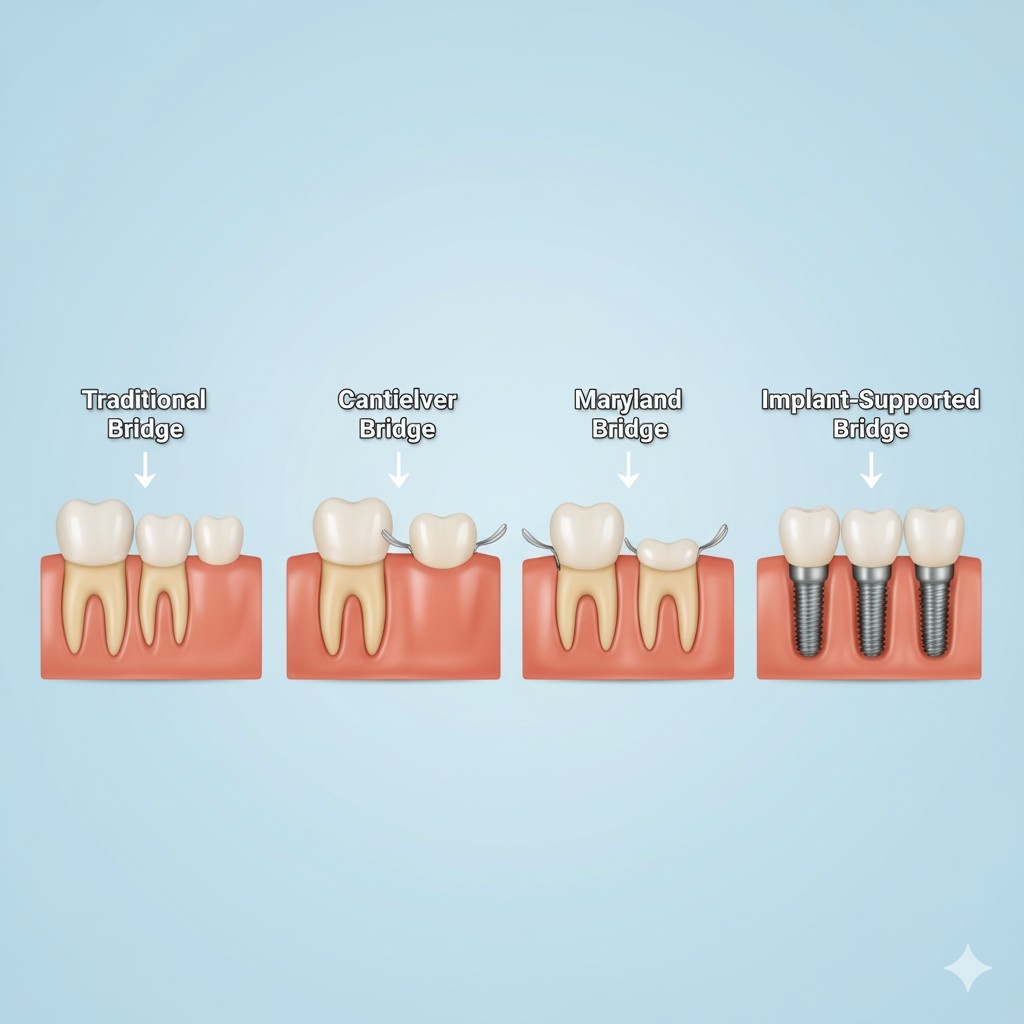Missing teeth can impact more than just your smile—they can affect your speech, ability to chew, and even your confidence. Fortunately, dental bridges offer a reliable and long-lasting solution to restore your smile and oral health. But did you know there’s more than one type of dental bridge?
At The Dental Place, we believe in educating our patients so they can make informed decisions about their dental care. In this blog, we’ll break down the four main types of dental bridges—Traditional, Cantilever, Maryland, and Implant-Supported—including how they work, their benefits, and when each is recommended.
What Is a Dental Bridge?
A dental bridge is a fixed (non-removable) prosthetic that “bridges” the gap created by one or more missing teeth. It consists of one or more artificial teeth (called pontics) anchored in place by abutment teeth on either side of the gap.
Dental bridges help:
- Restore your ability to chew and speak
- Maintain the shape of your face
- Prevent remaining teeth from shifting
- Improve the appearance of your smile
Let’s explore the different types of bridges and which one may be best for your needs.
-
Traditional Dental Bridge
✅ Best for: Patients with natural teeth on both sides of the missing tooth
A traditional dental bridge is the most common type. It involves placing crowns on two healthy teeth adjacent to the missing tooth, which serve as anchors. A false tooth (or teeth) is then suspended between them.
How it works:
- The dentist reshapes the two adjacent teeth
- Crowns are placed on these abutment teeth
- The pontic is fused between the crowns to complete the bridge
Pros:
- Strong and durable
- Ideal for replacing one or more teeth in a row
- A well-established and proven method
Cons:
- Requires removal of enamel from healthy teeth
- May not be suitable if adjacent teeth are weak or already damaged
-
Cantilever Dental Bridge
✅ Best for: Patients who only have natural teeth on one side of the missing tooth
A cantilever bridge is similar to a traditional bridge but only uses one tooth as the anchor. It’s used when only one adjacent tooth is available to support the bridge.
How it works:
- A crown is placed on one abutment tooth
- The pontic is attached to the single crown
Pros:
- Requires fewer teeth for support
- Useful in specific cases where a second anchor tooth isn’t available
Cons:
- Less stable than traditional bridges
- Not ideal for areas that take a lot of bite pressure (like molars)
- Higher risk of damage to the abutment tooth over time
- Maryland Dental Bridge (Resin-Bonded Bridge)
✅ Best for: Replacing front teeth or when minimal alteration is desired
The Maryland bridge, also known as a resin-bonded bridge, is a more conservative option that doesn’t require reshaping adjacent teeth.
How it works:
- A pontic is supported by a metal or porcelain framework
- The framework is bonded to the back of the adjacent teeth using resin
Pros:
- Minimal damage to surrounding teeth
- Aesthetic option for front teeth
- Less invasive than traditional bridges
Cons:
- Less durable—may not withstand heavy chewing
- Can debond more easily than other types
- Not suitable for areas of high bite force
-
Implant-Supported Dental Bridge
✅ Best for: Patients missing multiple teeth and seeking a long-term solution
An implant-supported bridge is anchored to dental implants instead of natural teeth. Dental implants are titanium posts surgically placed into the jawbone, serving as artificial roots.
How it works:
- Implants are placed in the jaw
- After healing, the bridge is attached to the implants
Pros:
- Does not rely on natural teeth for support
- Extremely stable and secure
- Preserves jawbone and facial structure
- Long-lasting—can last decades with proper care
Cons:
- Requires surgery and longer treatment time
- Higher initial cost
- Not suitable for patients with inadequate bone density (without grafting)
Which Dental Bridge Is Right for You?
Choosing the right type of dental bridge depends on several factors, including:
- The location of the missing tooth
- The condition of the surrounding teeth
- Your budget
- Your long-term oral health goals
At The Dental Place, our experienced dental team will carefully evaluate your needs and walk you through your options. We use the latest dental technologies and materials to ensure your bridge looks natural, feels comfortable, and lasts for years.
Restore Your Smile with Confidence
Missing teeth don’t have to be permanent—and you don’t have to live with discomfort or embarrassment. With a custom dental bridge from The Dental Place, you can restore function, boost your confidence, and enjoy the beauty of a complete smile.
Ready to take the next step?
📞 Contact The Dental Place today to schedule your consultation and find out which dental bridge is right for you.
Let’s rebuild your smile—beautifully and confidently.




